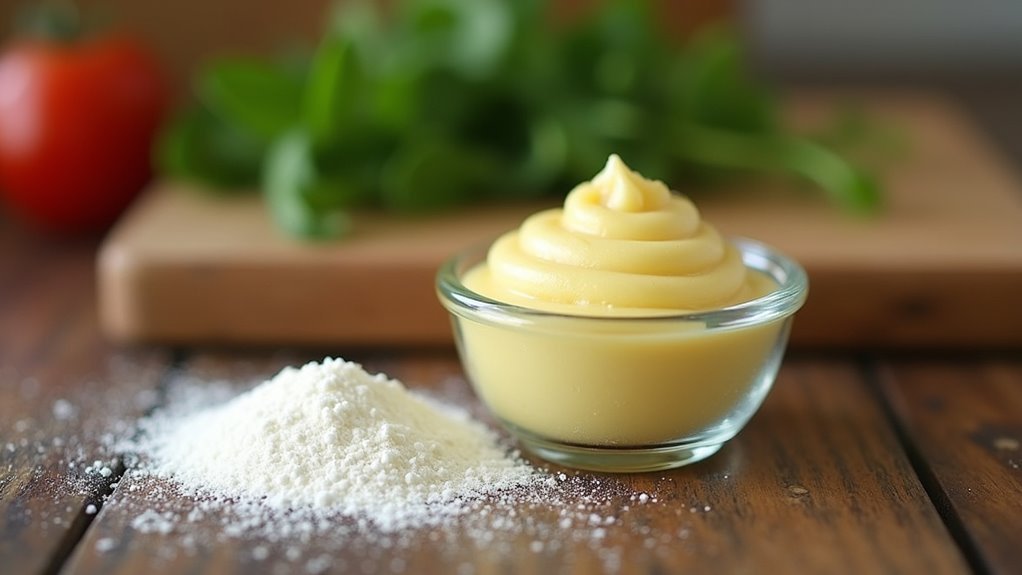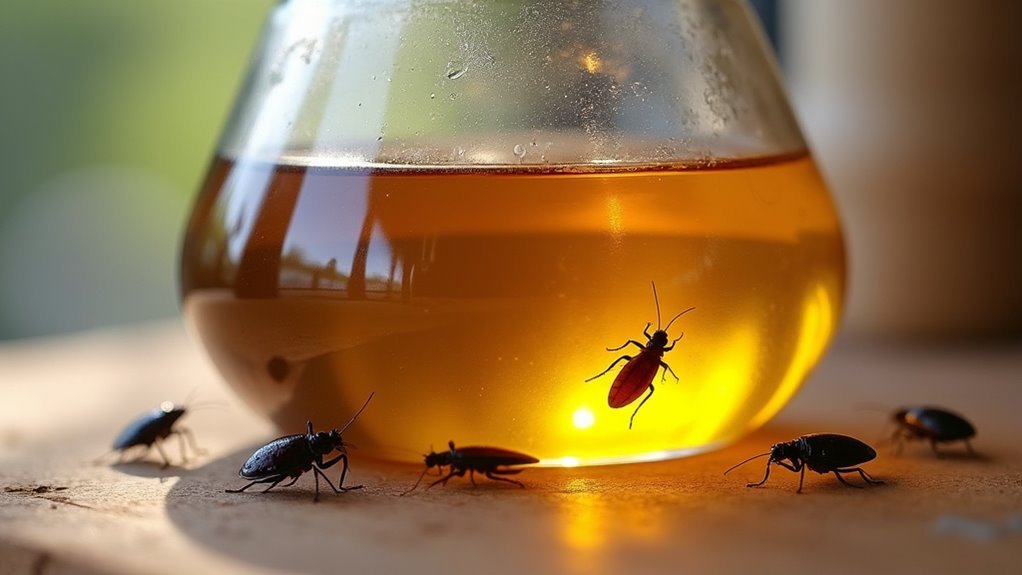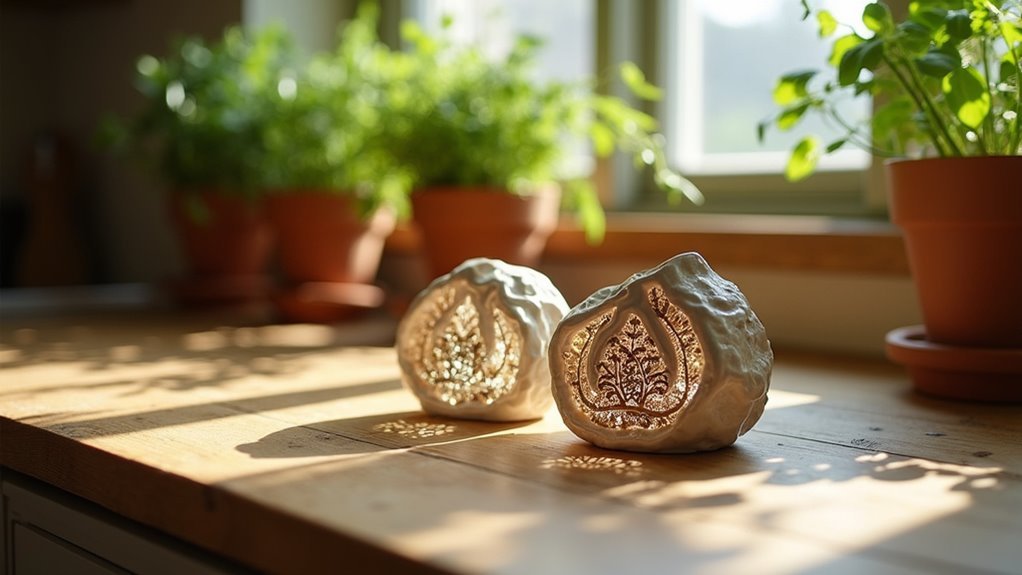You can eliminate kitchen roaches using effective homemade traps with common household ingredients. Mix three parts boric acid with one part sugar to create deadly bait stations, or construct funnel traps from soda bottles filled with sugar water. Oil-coated jars with honey work excellently too. Place these traps near appliances, under sinks, and along roach travel routes for maximum effectiveness. Keep them away from children and pets for safety. Strategic placement and proper maintenance will help you discover thorough solutions for complete roach elimination.
Understanding Why Roaches Invade Your Kitchen

When you’re dealing with a roach problem in your kitchen, understanding what attracts these unwelcome visitors is your first step toward effective control.
Your kitchen provides everything these pest invaders need: food sources like crumbs and grease, water from leaky pipes, and warm hiding spots. Roaches can squeeze through tiny cracks around windows, doors, and vents to access your space.
They’ll even hitch rides on your groceries and packages, bringing infestations directly into your home. The German cockroach particularly loves your kitchen’s humid, warm environment for nesting.
What makes this pest especially problematic is reproduction rates—a single female can produce 400 offspring, turning small problems into major infestations quickly.
Essential Ingredients for Homemade Roach Baits
You’ll need two main types of ingredients to create effective homemade roach baits that actually work.
Boric acid serves as your primary killing agent, disrupting the roaches’ digestive systems when they consume it.
Sweet attractants like powdered sugar, honey, or maple syrup draw the pests to your bait, ensuring they can’t resist taking the deadly meal back to their hiding spots.
Boric Acid Basics
Boric acid stands as one of the most effective weapons in your arsenal against kitchen roaches. This powerful insecticide disrupts their digestive systems, leading to death when consumed.
You’ll achieve peak effectiveness by mixing boric acid with sweet attractants like sugar or Karo syrup to create irresistible roach bait.
Follow this proven ratio for your DIY mixture:
- One part boric acid to three parts sugar or flour
- Mix thoroughly to guarantee even distribution
- Place strategically under appliances, in cabinets, and along baseboards
Target areas where roaches frequently travel for best results.
Remember to keep all boric acid baits away from children and pets, as ingestion can be harmful. This natural approach provides effective roach elimination without relying on commercial pesticides.
Sweet Attractant Options
Since roaches can’t resist sweet temptations, selecting the right attractant becomes crucial for your homemade bait’s success.
You’ll find that Karo syrup, honey, maple syrup, and simple syrup work exceptionally well as sweet attractants because they create irresistible lures that draw roaches directly to your traps.
When crafting your homemade roach bait, combine powdered sugar with borax or boric acid for a deadly yet appealing mixture. The sugar acts as bait while the poison eliminates the pests.
You’ll want to create a paste-like consistency that’s easy to place in roach-prone areas.
Consider adding rice flour to enhance your bait’s appeal, as it provides an additional food source that increases effectiveness.
Mix these ingredients thoroughly to guarantee even distribution of both attractant and poison throughout your homemade solution.
Boric Acid and Sugar Paste Trap Method

One of the most effective homemade roach traps combines boric acid with sugar to create a deadly yet irresistible bait.
You’ll need three parts boric acid to one part sugar, mixing them into a paste that roaches can’t resist. The sugar attracts them while the boric acid acts as the lethal component.
Place small amounts in strategic locations where roaches frequent:
- Under kitchen appliances like refrigerators and stoves
- Behind cabinets and drawers
- Near water sources and dark corners
When roaches consume this mixture, they’ll carry the boric acid back to their nest, effectively spreading it throughout the colony to kill roaches beyond just the initial victims.
You’ll typically see results within two weeks, and the trap remains effective for up to a year.
Soda Bottle Funnel Trap Design
When you’re looking for a chemical-free alternative, the soda bottle funnel trap offers an ingenious solution that costs practically nothing to make.
Simply cut the top third off any plastic soda bottle and invert it into the bottom section, creating a funnel entrance. This design allows roaches to crawl in easily but makes escaping nearly impossible.
Add effective bait like sugar water or peanut butter to the bottom portion. Smooth any rough edges around the funnel to prevent injury and improve trap performance.
Place these traps strategically under sinks, near garbage areas, or along kitchen counters where you’ve spotted roach activity.
Check your traps regularly and dispose of captured roaches promptly to maintain effective pest control throughout your kitchen.
Oil-Coated Jar Trap Technique

You’ll need an empty jam jar and cooking oil to create this effective roach trap.
Start by coating the jar’s interior with a thin layer of oil, which prevents roaches from climbing out once they’ve entered.
The oil application should be even but not excessive – just enough to create a slippery surface that traps the pests inside.
Jar Preparation Steps
Creating this effective oil-coated jar trap requires just a few simple materials you likely have in your kitchen already.
Start with an empty jam jar and apply a thin layer of cooking oil around the inside rim. This slippery coating prevents roaches from climbing out once they’ve entered your jar trap.
Next, add your attractive bait to the bottom of the jar. The most effective options include:
- Peanut butter (roaches love the smell and texture)
- Honey (provides irresistible sweetness)
- Sugar (acts as a powerful attractant)
Place enough bait to create a strong scent that’ll draw roaches in, but don’t overfill. You want them focused on getting inside rather than eating from the jar’s edge.
Oil Application Method
The success of your jar trap depends entirely on applying the oil correctly to create an inescapable barrier. Pour a small amount of cooking oil into your jar and tilt it to coat the entire inside rim. The oil application method requires covering approximately two inches down from the top edge to prevent roaches from climbing out once they’ve fallen in.
| Oil Type | Coverage Area | Application Tip |
|---|---|---|
| Vegetable Oil | 2 inches from rim | Tilt jar slowly |
| Olive Oil | Inner rim only | Use cotton swab |
| Coconut Oil | Full interior walls | Warm jar first |
Ensure the coating remains thick enough to maintain the trap’s effectiveness throughout multiple captures.
Diatomaceous Earth Placement Strategy
While diatomaceous earth proves effective against roaches, its success depends entirely on strategic placement in areas where these pests travel most frequently.
You’ll want to place it in areas like baseboards, behind appliances, and inside cabinets where roaches commonly hide and forage.
Before application, verify surfaces are completely clean and dry, as moisture reduces the powder’s killing power.
Apply only a thin layer—thick coatings actually prevent roaches from making contact with the diatomaceous earth.
Follow these key maintenance steps:
- Reapply every few weeks or after cleaning
- Monitor roach activity and adjust placement accordingly
- Focus on high-traffic areas and potential hiding spots
This strategic approach maximizes your chances of eliminating roaches naturally and effectively.
Essential Oil Spray Applications
Although chemical sprays dominate store shelves, essential oil-based solutions offer a powerful yet pet-safe alternative for controlling roaches in your kitchen.
Rosemary oil delivers exceptional results, achieving up to 100% mortality rates when you mix concentrations between 2.5% to 30% with water in a spray bottle. This natural approach rivals professional pest control effectiveness while keeping your family safer.
You can also use eucalyptus and lavender oils for repelling roaches, though exercise caution around pets.
These essential oils provide dual benefits: they eliminate pests while leaving pleasant aromas throughout your home.
Apply your essential oil sprays regularly along baseboards, under appliances, and near entry points. This consistent application supports your thorough pest management strategy when combined with other natural methods.
Cornmeal and Borax Bait Stations
Creating effective bait stations becomes simple when you combine equal parts cornmeal and Borax to form a deadly yet discreet trap system. The cornmeal’s appealing scent attracts roaches while the Borax disrupts their digestive systems, creating a slow-acting poison that eliminates entire colonies.
Place these strategic stations in roach hotspots:
- Under kitchen sinks and behind appliances
- Inside cabinets and pantry areas
- Near water sources and food storage zones
You’ll maintain safety around pets and children by positioning stations in hard-to-reach locations.
The cornmeal and Borax combination proves potent against roach populations over time. Check your bait stations regularly and replenish them when needed, as moisture and humidity can reduce Borax effectiveness.
This DIY solution offers consistent results without expensive commercial products.
Strategic Trap Placement in Kitchen Areas
Since roaches follow predictable travel patterns through your kitchen, you’ll maximize trap effectiveness by positioning them along these natural highways.
Place your bait station under sinks where moisture attracts roaches, behind refrigerators and stoves where they hide, and in dark corners they use as travel routes. You’ll want to place the bait near food sources like pantries and countertops where roaches actively forage.
Strategic bait placement in moisture-rich areas like under sinks and near appliances targets roaches where they naturally congregate and travel.
Focus on high-traffic areas by observing roach droppings or seeing them scurry at night. Use multiple trap types—sticky traps, jar traps, and bait stations—throughout different zones for thorough monitoring.
Check traps weekly and replace stale bait to maintain attractiveness. Position traps flush against walls since roaches prefer traveling along edges rather than crossing open spaces.
Safety Precautions for Household Members and Pets
When setting up natural roach traps in your kitchen, you’ll need to prioritize the safety of children and pets who share your home.
Strategic placement becomes essential since many trap ingredients can pose health risks if accidentally ingested by curious little ones or furry family members.
You’ll want to implement specific child-safe positioning techniques and pet protection measures that keep your traps effective while maintaining household safety.
Child-Safe Placement Strategies
Although homemade roach traps offer an effective pest control solution, you’ll need to implement strategic placement to protect children and pets from potential hazards.
Focus on inconspicuous locations that remain inaccessible to curious hands and paws. Position traps behind major appliances like refrigerators, dishwashers, or stoves where children can’t reach them. You’ll effectively keep roaches while maintaining child safety by choosing elevated spots on top of cabinets or behind furniture.
Consider these essential placement strategies:
- Install child safety locks on cabinets containing stored traps or bait materials.
- Use high shelving areas that remain completely out of children’s sight and reach.
- Monitor trap locations regularly while keeping them hidden from household members.
Educate your family about these traps’ purpose and emphasize the importance of never disturbing them for maximum safety and effectiveness.
Pet Protection Measures
Your furry companions face unique risks from homemade roach traps, requiring specialized protection strategies beyond those needed for children.
Store pet food in sealed containers since it attracts roaches and can be contaminated by trap ingredients.
Place traps in elevated areas where pets can’t reach but roaches still travel, such as behind appliances or inside cabinets with secure child locks.
Essential oils like peppermint repel roaches naturally while being safer around animals than boric acid or borax.
Monitor trap locations daily, removing dead roaches immediately before curious pets investigate.
Choose natural deterrents over chemical baits whenever possible to protect both children and pets simultaneously, creating a pest-free kitchen environment without compromising your family’s safety.
Monitoring and Maintaining Your Trap System
Since establishing your natural roach trap system is only the beginning, you’ll need to maintain consistent monitoring to guarantee peak performance.
Effective monitoring requires checking your traps every few days to assess roach activity and make certain they’re functioning properly.
To maximize your trap system’s effectiveness, follow these essential maintenance steps:
- Replace bait weekly – Fresh peanut butter or sugar maintains attractiveness and prevents stale odors.
- Keep detailed logs – Record capture numbers from each trap to gauge system performance over time.
- Clean traps regularly – Remove debris and maintain hygiene to avoid deterring roaches.
Position your traps in high-traffic areas where you’ve previously spotted roaches or droppings.
This strategic placement enhances monitoring potential and increases capture rates considerably.
Preventing Future Roach Infestations Naturally
While trapping existing roaches addresses your immediate problem, preventing future roach infestations naturally requires an extensive approach that eliminates the conditions these pests find attractive.
You’ll need to maintain a spotless kitchen by regularly vacuuming crumbs and spills that serve as food sources. Store all food, including pet food, in airtight containers to deny roaches easy access to nutrition.
Seal cracks, crevices, and gaps around doors and windows to block entry points. Create an inhospitable environment using natural repellents like rosemary or eucalyptus essential oils.
Don’t forget to inspect and clean behind appliances regularly, removing hidden food sources and potential nesting sites. This DIY roach prevention strategy works more effectively than relying solely on traps for long-term control.
Frequently Asked Questions
What Is the Best Natural Roach Trap?
You’ll find the best natural roach trap combines sugar and baking soda. The sugar attracts roaches while baking soda kills them when ingested. It’s effective, safe, and doesn’t require harmful chemicals.
Do Homemade Cockroach Traps Work?
Yes, you’ll find homemade cockroach traps work effectively for minor infestations. They’re great for monitoring and reducing populations, but you shouldn’t rely on them alone for serious roach problems requiring stronger methods.
How Do I Get Rid of Roaches in My Kitchen Permanently?
You’ll permanently eliminate roaches by storing food in airtight containers, cleaning spills immediately, using boric acid bait, sprinkling diatomaceous earth where they’re seen, and maintaining strict sanitation habits daily.
What Is the Most Effective Homemade Cockroach Killer?
You’ll find the most effective homemade cockroach killer combines three parts borax with one part sugar. This mixture attracts roaches while poisoning them, creating a deadly bait that eliminates infestations completely.
In Summary
You’ve now got multiple effective homemade traps to combat your roach problem naturally. Remember to place them strategically, monitor them regularly, and keep safety in mind around kids and pets. Don’t forget that prevention’s just as important as elimination – maintain cleanliness, seal entry points, and eliminate food sources. With consistent effort and these proven methods, you’ll reclaim your kitchen from unwanted invaders without relying on harsh chemicals.





Leave a Reply